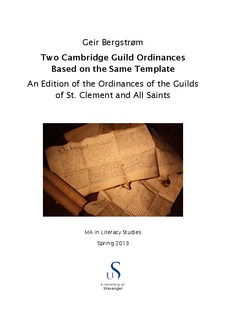| dc.description.abstract | The thesis presents a diplomatic edition of two mediaeval guild ordinances from Cambridge: the Statutes and Ordinances of the Gild of St. Clement and the Statutes and Ordinances of the Gild of All Saints. In addition, reference is made to a third, presumably lost, text, the Statutes and Ordinances of the Gild of St. Peter and Paul, which survives in a transcription from the late 17th or early 18th Century. These three manuscripts appear to be based on the same template. They are, however, not identical in terms of content or language.
There already exists a collated edition of the three texts, by Toulmin Smith (1870). His edition is largely unconcerned with language and is as such less than ideal from the point of view of historical linguistics. Furthermore, his edition is incomplete, as it leaves out several pages at the end of the ordinances of the Gild of St. Clement. Several of these are written in different hands, and are linguistically and palaeographically different from the previous pages.
As well as presenting an edition of these two manuscripts, the thesis presents a close study of the dialect and physical makeup of the texts, as well as a detailed comparison of their form and content. It also compares where the language of the texts ‘fit’ in ‘linguistic space’ to their provenance in ‘real space’ (Williamson 2000). By carrying out such a comparison, the study aims to build up a clearer idea of the dialectal background of these texts and of the scribal communities that produced them.
The first part of the thesis provides a textual, historical and linguistic contextualisation for the edited texts and carries out a study of their dialects. The two manuscripts are described, and the contents of all three texts, including the later transcription, are summarized. The first part also includes background chapters on guilds, guild ordinances, and Cambridge as a text community. Finally, the dialects of the three texts are described and localized. It is suggested that one of the texts is written in a more northern dialect than the others and that it is localizable to north-east Cambridgeshire, near the Isle of Ely.
The second part of the thesis consists of the edited texts, with a presentation of the conventions, commentary and notes. The thesis includes two appendices: a List of Measurements and a List of Currencies. | no_NO |
